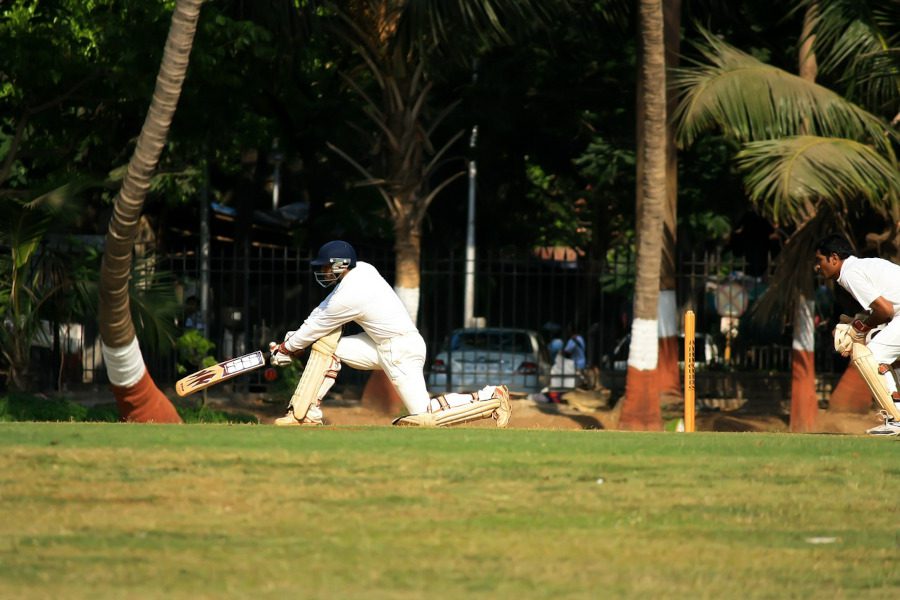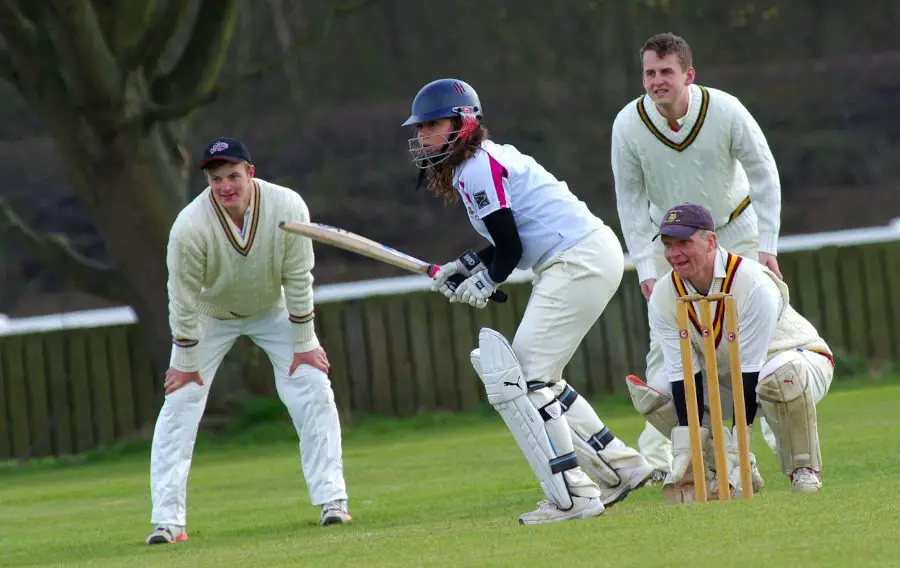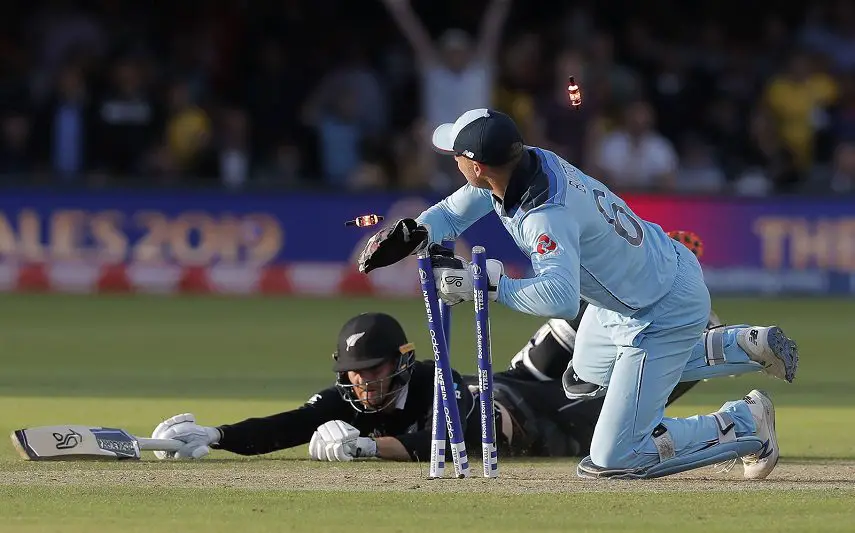Table of Contents
Originally there were 11 of them, but as the laws of cricket changed, there are altogether 10 ways to get out in cricket as of 2025.
Dismissals play a major role in any cricket match and they are pivotal to the overall result. The fielding side needs to claim dismissals in order to progress towards a win while the batting team has to avoid them.
All 10 Ways to Get Out in Cricket
These are the ten methods of dismissal in cricket as of 2025.
1. Caught
This dismissal is covered by law number 33 and it relates to the bat hitting the ball and being caught by a fielder before touching the ground. This catch needs to be judged as fair and the delivery must be a legal one. If the bowler has delivered a no ball, the dismissal will not be upheld.
Catches claimed by outfielders are usually obvious and the umpire does not need to make a decision. The general exception to that rule relates to catches claimed by the wicket-keeper (see chart below) where the ball strikes the edge of the bat. The batsman has the right to stand their ground and allow the umpire to adjudicate as to whether the batter is out or not.
There are some points to the law which need to be kept in mind. In order for a catch to be fair, the ball must not hit the ground before it reaches the fielder or be in contact with the ground as the catch is claimed. The fielder must be in full control of the ball before they release it and they must not be in contact with the boundary markers.
If all of those points are met, the catch is deemed to be fair and the bowler is dismissed.
Catches to the wicket keeper can be reviewed by the Decision Review System to see if the ball has struck the batter’s bat or glove. DRS can also be called upon for catches in the outfield. We frequently see fielders in the deep claiming a catch when the ball is close to the ground. If there is any doubt, the standing umpires will ask the third official to adjudicate on this point.
Caught is the most common form of dismissal in cricket with over half of wickets falling in this fashion. Using figures relating to test cricket which will be similar in all forms, statistics show that 58.6% of dismissals are caught.

2. Bowled Out
Law 32 covers this particular dismissal. The batsman is deemed to have been bowled if a legal delivery strikes their wicket and puts it down. In order for that wicket to be deemed as ‘put down’ at least one of the bails must be dislodged and fall to the ground.
The delivery can strike the wicket unimpeded or it can hit the bat or any part of the batsman’s body before it hits the stumps. The dismissal, once it has occurred, should be obvious and would not usually require the umpire to adjudicate.
Once again, this must be a legal delivery, and if the bowler has sent down a no ball, the batter cannot be bowled out.
Bowled dismissals are also very common no matter what the form of the game may be. Official figures indicate that 21.3% of batsmen are out in this way.

3. Leg Before Wicket (LBW)
LBW dismissals are governed by law 36 and this was introduced to prevent batsmen from deliberately blocking the wicket with their legs or any other part of their body. A batsman can, therefore, be dismissed if a legal delivery strikes any part of their body and is adjudged to have been hitting the stumps. That delivery does not necessarily need to hit the legs and the batsman’s act does not have to be deliberate.
There are certain caveats regarding the LBW law which makes it the most complex of all dismissals. Firstly, the ball cannot pitch outside of the leg stump and if it’s judged to have been the case, the batsman should not be given out.
The delivery must also hit in line with the stumps. If the ball is deemed to have struck the batsman outside of the off stump and he or she is playing a shot, lbw should not be upheld. However, if the batsman is not playing a shot, LBW is permissible. Finally, LBW should not be given if the ball hits the bat or the batsman’s glove before striking their body.
LBW dismissals are entirely down to the judgement of the umpire. A fielding team will appeal and it’s down to the umpire to make the decision. In the modern game, however, there is the option for the batter or the bowling side to refer any final decision to DRS.
The figures relating to LBW laws show that 14.4% of all batters are dismissed by this method. It will be interesting to see if those numbers have increased since the introduction of the Decision Review System (DRS).
4. Run Out
Governed by Law 38, a batsman is deemed to be run out if a member of the fielding team puts down the wicket while that batsman is out of their ground. In order to be within their ground, the batter should have some part of the bat or their body behind the popping crease before the wicket is broken. If the bat or part of the body is on the line, the run out appeal should be upheld.
The point at which that wicket is put down is defined as the moment that the bail is dislodged from the stumps and subsequently falls to the ground. In limited overs cricket, those bails that light up when they are dislodged are extremely helpful to the umpires. In most cases, a run out dismissal takes place when the batsmen are attempting a run. However, a run out can occur if the batter simply falls or wanders out of their crease and the wicket is put down by a fielder.
Run outs are often tight calls and the adjudication, in the majority of cases, is undertaken by the third umpire. However, it should be remembered that in games when there is no TV replay available, the decision is solely down to the standing officials.
Run out is a less common dismissal in test cricket with just 3.46% of wickets falling in this fashion. Those numbers are likely to increase in limited overs cricket, but this is still a relatively rare way to get out.

5. Stumped
Stumped is a form of dismissal that is carried out specifically by the wicketkeeper (see chart below). This is covered by law 39 and it starts when a batsman leaves their crease in order to play a delivery. If the ball passes the stumps and the wicket is put down by the wicket keeper, the batter is deemed to be out if no part of their bat or body is behind the popping crease.
If a batsman is attempting a run, the dismissal is marked down as run out but if they have simply left the crease to play the ball, the batter is ‘stumped.’
Statistics relating to stumped dismissals show that 2.02% of test batsmen are out in this manner. Once again, that number could potentially increase in limited overs formats but stumped is likely to remain as the fifth most common way of being given out.
An interesting point to note is that a batter can be given out stumped from a wide delivery, but they cannot be stumped from a no ball. On that subject, if a wicket keeper takes the ball in front of the stumps, it should lead to a no ball call from the square leg umpire.
6. Hit Wicket
Hit Wicket dismissals are covered by cricket’s law 36. A batsman is deemed to be out hit wicket if they break the wicket with their bat or any part of their body while playing a shot or attempting their first run. A dismissal can also be affected if a part of their equipment is dislodged and breaks the wicket as a result of that delivery. This happens on occasions when the batsman’s helmet has dropped down onto the stumps.
The delivery must be a legal one (meaning, that it’s not a no ball) and, once again, the wicket is deemed to be put down if the bail is dislodged and subsequently falls to the ground.
Hit wicket dismissals are relatively rare in all forms of the game with 0.230% of all dismissals falling in this fashion. I can remember one of the most memorable hit wicket occasions came in the 1975 ODI World Cup final when the West Indies’ Roy Fredericks trod on his stumps after hitting the ball for six.
7. Obstructing the Field
Obstructing the Field covers the now defunct dismissal of ‘handled the ball.’ It is covered by law 37 which states that the batsman can be given out if he wilfully obstructs the fielding side either with their body or with words or other actions.
Typically, an appeal for obstructing the field will be upheld if a batsman deliberately prevents a fielder from taking a clean catch. Another common dismissal occurs when a batter changes their course of direction to prevent a run out. The fielding side is required to appeal and both umpires can consult before coming to a decision.
The handled the ball dismissal was part of the laws prior to the change. This occasionally occurred when the batsman stopped the ball from hitting the stumps by using their hand.
We’re into the realms of real rarities now and less than 0.01% of dismissals come from obstructing the field. Examples of this include Ben Stokes who was given out when he handled the ball in an ODI against Australia in 2015.
8. Hit the Ball Twice
Governed by Law 34, Hit the Ball Twice is an exceptionally rare dismissal. As the name indicates, if the batsman hits the ball willfully a second time after it has initially hit the bat or a part of their body / clothing, the batsman can be given out.
There is an exception to this rule as batsmen can use their bat, or any part of their body other than their hands, to prevent the ball from hitting the stumps. If this is the case, the second hit is deemed to be lawful but if the strike is wilful for any other reason, the umpire can uphold an appeal for Hit the Ball Twice.
This is another dismissal where the percentage figures are way below 0.01. This is the second rarest form, just ahead of timed out. There have been no instances of Hit the Ball Twice in test cricket and it’s said that there have only been 21 such dismissals in all formats as of 2021.

9. Timed Out
Once a batsman has been dismissed for any reason, the incoming batter has three minutes in which to take to the field and assume their position at the crease. If they wilfully do not comply with this limit, the fielding side can appeal and the umpire should uphold the dismissal as ‘timed out’.
This comes under law 40 of the laws of cricket and timed out is another exceptionally rare dismissal.
Timed Out is exceptionally rare and there have been no instances of this in test cricket. In the long history of first class cricket, only seven batters have been given out in this way. In 2023, Angelo Mathews became the first batter to be given out Timed Out in test cricket. Playing for Sri Lanka against Bangladesh, a broken helmet strap meant that he wasn’t ready within the three minute timeframe.
As a footnote to this dismissal, certain T20 franchise competitions have played around with this law. In order to speed up the game, they have shortened the timeframe for a batter to reach their crease.
10. Retired Out
During their innings, a batsman can leave the field of play for a legitimate reason – usually injury or some other form of incapacity. This should be done with the umpire’s consent but if the reason is obvious and admissible, they are clearly going to allow it.
However, if the batter leaves the field without permission or for a reason that is not justified, they can be dismissed as retired out. This has happened on rare occasions and it usually occurs when a batsman leaves the field with a view to giving their colleagues some time at the crease. Therefore, it’s often the case that ‘retired out’ will sometimes appear on a scorecard for practice games.
This has never happened in test cricket and I think that it’s very unlikely that a test batsman will retire ‘out’. We only tend to see this dismissal in early tour matches where a batter retires after making a good score so that his teammates can get time at the wicket.
In limited overs cricket, I think we will start to see Retired Out becoming more common. If a batter is struggling and returning a low strike rate, they can retire and allow a more powerful batsman to take their place. We’ve seen it happen in T20 franchise competitions, and it will become more regular in the future.
What is a Dismissal in Cricket?
Dismissals are also referred to as ‘ways of getting out’. They are methods in which to claim the batsman’s wicket by getting him or her ‘out’ and to end their innings. The batting side starts their innings with ten wickets in hand so the fielding team needs to achieve ten dismissals to end that innings.
Sides will now change and the fielding side will bat. The process continues with the new batsmen having ten wickets in place. This is, essentially, the whole objective in cricket and this is why a dismissal is so critical to the game. By taking ten wickets for a low score, fielding teams gain an advantage. Similarly, by keeping those wickets intact and scoring as many runs as possible, that advantage switches to the batting side.
On the other hand, in the rare case of the batsman not scoring even a single run before getting dismissed, he or she risks scoring a duck, which affects their statistics and may give them a poor reputation.
Conclusion
Dismissals are an essential part of the game and it’s important to understand them. The laws of cricket can be complex but these are pivotal to gameplay and will enhance a viewer’s understanding and enjoyment if they are studied.
Cricket continues to evolve and we may see subtle changes to those laws in the future but the ten dismissals are well-established and should remain so for the time being.
On the other hand, there are cases when dismissals occur in incomprehensible ways, due either to the batsman’s mistake or a bad umpiring decision. At those particular occasions these dismissals seem to be less clear and up for debate.


